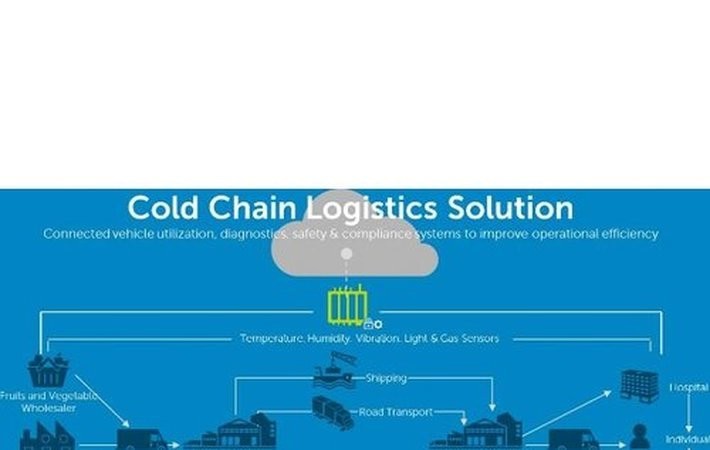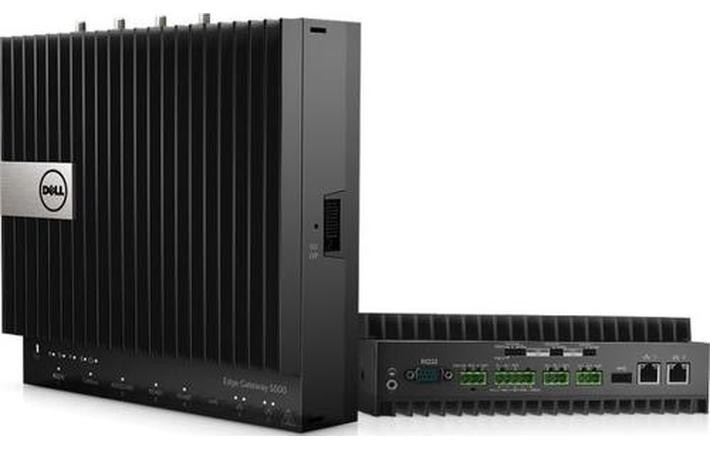
Published on 11/07/2016 | Operations
Cold chain logistics management is the use of Internet of Things (IoT) solutions to ensure the constant temperature for perishable products such as food, vaccines, pharmaceuticals, chemicals, or even medical supplies such as transplant organs.
Dell’s IoT transportation and logistics solutions enable data aggregation from sensors and edge analytics to take action on the data. This remote management and control of cold chains drives operational efficiency that results in reduced transportation time of perishable goods and leads to a reduction in spoilage.
The above figure captures the multiple steps in the cold chain that perishable goods will often traverse to get from a farm or medical supplier to various food distributors and retailers spanning multiple locations. Transportation time can be influenced by external factors (such as traffic, road conditions, and weather) which may lead to food spoilage if the conditions are not constantly monitored and controlled.
Fresh produce and perishable goods often need to be stored at a constant temperature with proper ventilation in order to maintain their desired humidity. Bananas are one such example – in order to preserve their freshness you need to maintain 62-70F and 85-95% humidity during transportation. Many pharmaceuticals and medical supplies have even tighter ranges to ensure that no degradation of effectiveness occurs during transport.
Sensors in containers, trailers, and pallets make it possible to continuously track and transmit data (such as temperature, humidity, vibration, light, and gas content) throughout the cold chain. The state of the containers can be recorded and monitored consistently during transportation to distributors and retailers.
These additional sensors are leading to an unprecedented explosion of devices connecting to the internet, forming the Internet-of-Things (IoT).
This sensor data is utilized by transport and logistics companies along the supply chain in different ways. Transportation providers use it to analyze, prioritize and re-route goods that could expire or spoil sooner than others. Wholesale vendors use this data to take appropriate action when goods are spoiled in order to fulfill their delivery obligations. Distributors use this data to allocate warehouse space and to schedule delivery to retail outlets. Finally, retailers use this data to re-prioritize the perishable goods and possibly lower the selling prices if they need to move them fast.
With all this data from sensors, environmental restrictions for different perishable goods could be significantly refined. The next step after analyzing data is using the sensor values to control the climate (temperature, humidity, gas content) within the cargo containers in real time to reduce spoilage. This requires a device capable of performing edge-analytics.
During transport, there is a high probability of sensors being unable to contact the centralized control room through the cloud. This requires a device that can collect and process data from these sensors locally while having intermittent connectivity with the cloud.
With this technology, there is an opportunity to drive supply chain efficiency, which can significantly change the lives of many people across the globe. Dell’s IoT gateways provide the solution for remotely monitoring and controlling the cold chain.

Dell IoT gateways are devices that collect, secure and process data from wired and wireless sensors at the edge of a network. They also communicate meaningful data to backend systems in the cloud, control room, or data center. Equipped with processing power, they provide the flexibility to perform analytics at the edge and/or in the cloud.
Dell’s IoT solution can help manage climate control, efficient routing, and asset tracking through embedded sensors leading to reduction in transportation time and more importantly, food spoilage reduction.
This article was originally posted on LinkedIn.